CFP: Word and Image
Ausstellung „Comic in der DDR“ in Gera verlängert
Das Stadtmuseum Gera verlängert seine Ausstellung „Comic in der DDR“ bis zum 19. März 2017.
Monitor 31: Neue Publikationen 2016/17
Im Monitor werden in unregelmäßigen Abständen aktuelle Publikationen aus den letzten 6 Monaten vorgestellt, die für die Comicforschung relevant sein könnten. Die kurzen Ankündigungstexte dazu stammen von den jeweiligen Verlagsseiten. Haben Sie Anregungen oder Hinweise auf Neuerscheinungen, die übersehen worden sind und hier erwähnt werden sollten? Das Team freut sich über eine Mail an redaktion@comicgesellschaft.de. -> Zu früheren Monitoren.
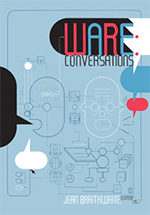
Chris Ware:
Conversations
Jean Braithwaite (Hrsg.)
University Press of Mississippi
272 Seiten
ISBN 978-1-4968-0929-2 (Hardcover)
~$ 40,00
November 2016
Verlagsseite
Like Art Spiegelman or Alison Bechdel, Ware stands out as an important crossover artist who has made the wider public aware of comics as literature. His regular New Yorker covers give him a central place in our national cultural conversation. Editor Jean Braithwaite compiles interviews displaying both Ware’s erudition and his quirky self-deprecation. They span Ware’s career from 1993 to 2015, creating a time-lapse portrait of the artist as he matures. Several of the earliest talks are reprinted from zines now extremely difficult to locate. Braithwaite has selected the best broadcasts and podcasts featuring the interview-shy Ware for this volume, including new transcriptions. An interview with Marnie Ware from 2000 makes for a delightful change of pace, as she offers a generous, supremely lucid attitude toward her husband and his work. Candidly and humorously, she considers married life with a genius in the house. Brand-new interviews with both Chris and Marnie Ware conclude the volume.
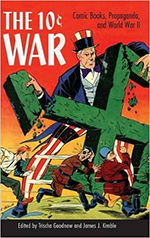
The 10 Cent War:
Comic Books, Propaganda, and World War II
Trischa Goodnow und James J. Kimble (Hrsg.)
University Press of Mississippi
240 Seiten
ISBN 978-1-4968-1030-4 (Hardcover)
~$ 65,00
Januar 2017
Verlagsseite
The Allied victory in World War II relied on far more than courageous soldiers. Americans on the home front constantly supported the war effort in the form of factory work, war bond purchases, salvage drives, and morale-rallying efforts. Motivating these men, women, and children to keep doing their bit during the war was among the conflict’s most urgent tasks. One of the most overlooked aspects of these efforts involved a surprising initiative―comic book propaganda. The 10 Cent War presents a riveting analysis of how different types of comic books and comic book characters supplied reasons and means to support the war effort. The contributors demonstrate that, free of government control, these appeals produced this overall imperative. The book discusses the role of such major characters as Superman, Wonder Woman, and Uncle Sam along with a host of such minor characters as kid gangs and superhero sidekicks. It even considers novelty and small presses, providing a well-rounded look at the many ways that comic books served as popular propaganda.
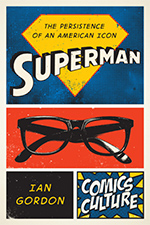
Superman:
The Persistence of an American Icon
Ian Gordon
Rutgers University Press
200 Seiten
ISBN 978-0-8135-8751-6 (Softcover)
~$ 28,95
Januar 2017
Verlagsseite
After debuting in 1938, Superman soon became an American icon. But why has he maintained his iconic status for nearly 80 years? And how can he still be an American icon when the country itself has undergone so much change? Superman: Persistence of an American Icon examines the many iterations of the character in comic books, comic strips, radio series, movie serials, feature films, television shows, animation, toys, and collectibles over the past eight decades. Demonstrating how Superman’s iconic popularity cannot be attributed to any single creator or text, comics expert Ian Gordon embarks on a deeper consideration of cultural mythmaking as a collective and dynamic process. He also outlines the often contentious relationships between the various parties who have contributed to the Superman mythos, including corporate executives, comics writers, artists, nostalgic commentators, and collectors.
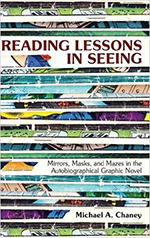
Reading Lessons in Seeing:
Mirrors, Masks, and Mazes in the Autobiographical Graphic
Michael A. Chaney
University Press of Mississippi
192 Seiten
ISBN 9-781-4968-1025-0 (Hardcover)
~$ 65,00
Februar 2017
Verlagsseite
Literary scholar Michael A. Chaney examines graphic novels to illustrate that in form and function they inform readers on how they ought to be read. His arguments result in an innovative analysis of the various knowledges that comics produce and the methods artists and writers employ to convey them. Theoretically eclectic, this study attends to the lessons taught by both the form and content of today’s most celebrated graphic novels. Chaney analyzes the embedded lessons in comics and graphic novels through the form’s central tropes: the iconic child storyteller and the inherent childishness of comics in American culture; the use of mirrors and masks as ciphers of the unconscious; embedded puzzles and games in otherwise story-driven comic narratives; and the form’s self-re exive propensity for showing its work. Comics reveal the labor that goes into producing them, embedding lessons on how to read the „work“ as a whole.
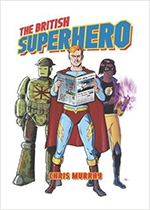
The British Superhero
Chris Murray
University Press of Mississippi
786 Seiten
ISBN 9-781-4968-0737-3 (Hardcover)
~$ 65,00
März 2017
Verlagsseite
Chris Murray reveals the largely unknown and rather surprising history of the British superhero. It is often thought that Britain did not have its own superheroes, yet Murray demonstrates that there were a great many in Britain and that they were often used as a way to comment on the relationship between Britain and America. Sometimes they emulated the style of American comics, but they also frequently became sites of resistance to perceived American political and cultural hegemony, drawing upon satire and parody as a means of critique. Murray illustrates that the superhero genre is a blend of several influences and that in British comics, these influences are quite different from those in America, resulting in some contrasting approaches to the figure of the superhero. He identifies the origins of the superhero and supervillain in nineteenth-century popular culture such as the penny dreadfuls and boy’s weeklies and in science fiction writing of the 1920s and 1930s. From the emergence of British superheroes in the 1940s, the advent of „fake“ American comics, and the reformatting of reprinted material to the British Invasion of the 1980s, and the pivotal roles in American superhero comics and film production held by British artists today, this book will challenge views about British superheroes and the comics‘ creators who fashioned them.

The Secret Origins of Comics Studies
Matthew Smith und Randy Duncan (Hrsg.)
Routledge
302 Seiten
ISBN 978-1-1388-8451-9 (Hardcover)
~£ 110,00
März 2017
Verlagsseite
In The Secret Origins of Comics Studies, today’s leading comics scholars turn back a page to reveal the founding figures dedicated to understanding comics art. Edited by comics scholars Matthew J. Smith and Randy Duncan, this collection provides an in-depth study of the individuals and institutions that have created and shaped the field of Comics Studies over the past 75 years. From Coulton Waugh to Wolfgang Fuchs, these influential historians, educators, and theorists produced the foundational work and built the institutions that inspired the recent surge in scholarly work in this dynamic, interdisciplinary field. Sometimes scorned, often underappreciated, these visionaries established a path followed by subsequent generations of scholars in literary studies, communication, art history, the social sciences, and more. Giving not only credit where credit is due, this volume both offers an authoritative account of the history of Comics Studies and also helps move the field forward by being a valuable resource for creating graduate student reading lists and the first stop for anyone writing a comics-related literature review.
Veranstaltungsreihe „Stories + Strips“ in Frankfurt

Im Rahmen der Veranstaltungsreihe „Stories + Strips“ finden unter dem Motto „Comics, Graphic Novels und die Leute die sie machen – 5x im Jahr die neunte Kunst zu Gast in Frankfurt a. M.“ an unterschiedlichen Orten und in unregelmäßigen Abständen Lesungen und Ateliergespräche mit nationalen und internationalen Comic-Künstlern statt. Die Reihe wird dieses Jahr mit den folgenden zwei Terminen eingeläutet:
Sarah Glidden – 24.2.2017, 19:00 Uhr, Bildungsstätte Anne Frank
Unter dem Titel „In die Realität: Mit Graphic Journalism gegen das Vergessen“ liest die US-amerikanische Zeichnerin Sarah Glidden aus ihren Comics. Anschließend spricht Patrick Bahners mit Sarah Glidden über die spezifischen Möglichkeiten und Probleme des Comics als Reportage (in englischer Sprache). Eine Veranstaltung im Rahmen der Ausstellung „Holocaust im Comic“.
Guy Delisle – 21.3.2017, 19:30 Uhr, Haus am Dom
Der kanadische Comicautor Guy Delisle, bekannt für seine Reportage-Comics, stellt sein neues Buch Geisel, das auf einer wahren Begebenheit beruht, vor. Lesung mit Bildern auf Deutsch. Das anschließende Gespräch mit dem dem Autor wird auf Englisch geführt und von Christian Maiwald moderiert.
Monitor 30: Neue Publikationen 2016/17
Im Monitor werden in unregelmäßigen Abständen aktuelle Publikationen aus den letzten 6 Monaten vorgestellt, die für die Comicforschung relevant sein könnten. Die kurzen Ankündigungstexte dazu stammen von den jeweiligen Verlagsseiten. Haben Sie Anregungen oder Hinweise auf Neuerscheinungen, die übersehen worden sind und hier erwähnt werden sollten? Das Team freut sich über eine Mail an redaktion@comicgesellschaft.de. -> Zu früheren Monitoren.
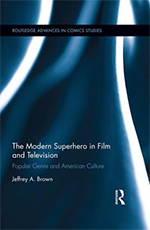
The Modern Superhero in Film and Television:
Popular Genre and American Culture
Jeffrey A. Brown
Routledge
182 Seiten
ISBN 978-1-1388-9778-6 (Hardcover)
~£ 85,50
November 2016
Verlagsseite
Hollywood’s live-action superhero films currently dominate the worldwide box-office, with the characters enjoying more notoriety through their feature film and television depictions than they have ever before. This book argues that this immense popularity reveals deep cultural concerns about politics, gender, ethnicity, patriotism and consumerism after the events of 9/11. Superheroes have long been agents of hegemony, fighting for abstract ideals of justice while overall perpetuating the American status quo. Yet at the same time, the book explores how the genre has also been utilized to question and critique these dominant cultural assumptions.
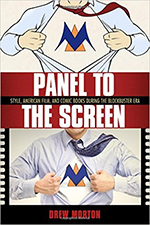
Panel to the Screen:
Style, American Film, and Comic Books during the Blockbuster Era
Drew Morton
University Press of Mississippi
208 Seiten
ISBN 978-1-4968-0978-0 (Hardcover)
~$ 65,00
November 2016
Verlagsseite
Over the past forty years, American film has entered into a formal interaction with the comic book. Such comic book adaptations as Sin City, 300, and Scott Pilgrim vs. the World have adopted components of their source materials‘ visual style. The screen has been fractured into panels, the photographic has given way to the graphic, and the steady rhythm of cinematic time has evolved into a far more malleable element. In other words, films have begun to look like comics. Yet, this interplay also occurs in the other direction. In Panel to the Screen, Drew Morton examines this dialogue in its intersecting and rapidly changing cultural, technological, and industrial contexts. Early on, many questioned the prospect of a „low“ art form suited for children translating into „high“ art material capable of drawing colossal box of ce takes. Now the naysayers are as quiet as the queued crowds at Comic-Cons are massive. Morton provides a nuanced account of this phenomenon by using formal analysis of the texts in a real world context of studio budgets, grosses, and audience reception.
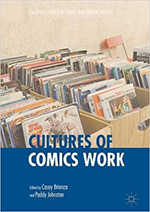
Cultures of Comics Work
Casey Brienza und Paddy Johnston (Hrsg.)
Palgrave MacMillan
308 Seiten
ISBN 978-1-137-55477-2 (Hardcover)
~€ 106,99
Dezember 2016
Verlagsseite
This anthology explores tensions between the individualistic artistic ideals and the collective industrial realities of contemporary cultural production with eighteen all-new chapters presenting pioneering empirical research on the complexities and controversies of comics work. Art Spiegelman. Alan Moore. Osamu Tezuka. Neil Gaiman. Names such as these have become synonymous with the medium of comics. Meanwhile, the large numbers of people without whose collective action no comic book would ever exist in the first place are routinely overlooked. Cultures of Comics Work unveils this hidden, global industrial labor of writers, illustrators, graphic designers, letterers, editors, printers, typesetters, publicists, publishers, distributors, translators, retailers, and countless others both directly and indirectly involved in the creative production of what is commonly thought of as the comic book. Drawing upon diverse theoretical and methodological perspectives, an international and interdisciplinary cohort of cutting-edge researchers and practitioners intervenes in debates about cultural work and paves innovative directions for comics scholarship.
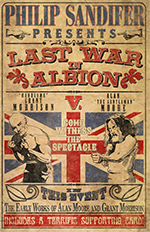
The Last War in Albion Volume 1:
The Early Work of Alan Moore and Grant Morrison
Phil Sandifer
Eruditorum Press
786 Seiten
ISBN 978-1-5404-8218-1 (Paperback)
~$ 22,99
Dezember 2016
Verlagsseite
In the late twentieth century, beneath the surface of Britain’s green and pleasant land, raged a war that spanned the heights of mystical transcendence and the most obscure gutters of popular culture. The stakes were unfathomably vast: the fate of the twenty-first century, the shape of an entire artistic medium, and whether or not several people would make their rent. On one side was Alan Moore, the acclaimed literary genius who would transform comics forever. On the other was Grant Morrison, the upstart punk who never met an idol he didn’t want to knock off its perch. In Volume One of this incredible tale you’ll learn how an ex-drug dealer from the slums of Northampton and a failed rock star from Glasgow made their way into the comics industry and found themselves locked in an artistic rivalry that would shake the very foundations of Britain. Starting from their beginnings writing and drawing comic strips like Captain Clyde and Maxwell the magic Cat and continuing through Moore’s breakout runs on Marvelman and V for Vendetta and explosion onto the US scene with Swamp Thing, it is the fantastically unlikely tale of how the British comics industry came to produce the two greatest wizards of their generation. This is the story of gothic rock and obscenity trials. Of William Blake and William S. Burroughs. Of Hieronymus Bosch and Enid Blyton. This is the story of the Last War in Albion.
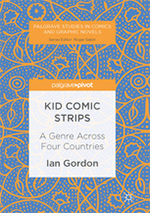
Kid Comic Strips:
A Genre Across Four Countries
Ian Gordon
Palgrave MacMillan
94 Seiten
ISBN 978-1-137-56197-8 (Hardcover)
~€ 49,99
Dezember 2016
Verlagsseite
This book looks at the humor that artists and editors believed would have appeal in four different countries. Ian Gordon explains how similar humor played out in comic strips across different cultures and humor styles. By examining Skippy and Ginger Meggs, the book shows a good deal of similarities between American and Australian humor while establishing some distinct differences. In examining the French translation of Perry Winkle, the book explores questions of language and culture. By shifting focus to a later period and looking at the American and British comics entitled Dennis the Menace, two very different comics bearing the same name, Kid Comic Strips details both differences in culture and traditions and the importance of the type of reader imagined by the artist.
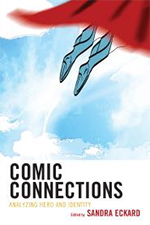
Comic Connections:
Analyzing Hero and Identity
Sandra Eckard (Hrsg.)
Rowman & Littlefield
154 Seiten
ISBN 978-1-4758-2802-3 (Paperback)
~$ 25,00
Januar 2017
Verlagsseite
Comics are all around campuses everyday, and with students arriving less prepared to tackle basics like reading, writing, and analyzing, this text helps connect what students enjoy to the classroom. Comic Connections: Analyzing Hero and Identity is designed to help teachers from middle school through college find a new strategy that they can use right away as part of their curricular goals. Each chapter has three pieces: comic relevance, classroom connections, and concluding thoughts; this format allows a reader to pick-and-choose where to start. Some readers might want to delve into the history of a comic to better understand characters and their usefulness, while other readers might want to pick up an activity, presentation, or project that they can fold into that day’s lesson.